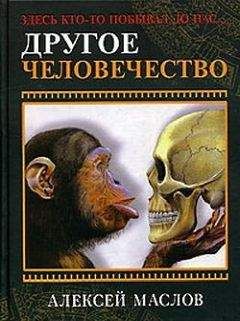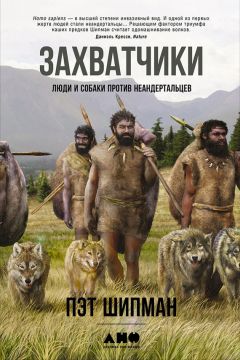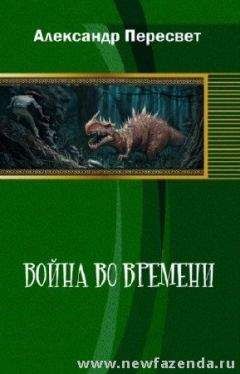Алексей Маслов - Другое человечество. Здесь кто-то побывал до нас...

Помощь проекту
Другое человечество. Здесь кто-то побывал до нас... читать книгу онлайн
144. Foley R.A. (ed.). Hominid evolution and community ecology. New York: Academic Press, 1984.
145. Foley R.A. and P.C. Lee. Finite social space, evolutionary pathways, and reconstructing hominid behavior // Science 1989, N 243: 901-6.
146. Foley R.A. and R. Dunbar. Beyond the bones of contention. // New Scientist 1989, N 14 (October): 37:1.
147. Foley R.A. Another unique species. London: Longman, 1987.
148. Foley R.A. Hominid species and stone-tool assemblages: how are they related? // Antiquity 1987, N 61:380-92.
149. Foley R.A. How many species of hominid should there be? // Journal of Human Evolution 1991, N 20:413-27.
150. Foley R.A. Off-site archaeology and human adaptation in eastern Africa. Oxford: British Archaeological Reports, 1981.
151. Foley R.A. Optimality theory in anthropology // Man 1985, N 20: 222-42.
152. Folger T. The Naked and the Bipedal // Discover, 1993, 14 (11)
153. Frayer D.W. Evolution at the European Edge: Neanderthal and Upper Paleolithic relationships // Prehistoire Europenne, 1993, N 2:9-69.
154. Freedman S., and Causer, J., 1972, Experimental test of local hidden Variables Theories in Physical Review Letters, Vol. 28, p. 938.
155. Gabunia L., de Lumley M.-A., Vekua A., Lordkipanidze D., and de Lumley H. Decouvert d’un nouvel hominide а Dmanissi (Transcaucasie, Georgie). C.R.Palevol // Nature 2002 N 1:243-53.
156. Gallois R. W. The Wealden District, Institute of Geological Sciences, London, 1965.
157. Gee H. Statistical cloud over African Eve // Nature, 1992, 355:583.
158. Gesner J. Traite des Petrifications. Leyde, 1758.
159. Goldschmidt R, The Material Basis of Evolution, Yale University Press, 1940.
160. Goodman J. American Genesis. New York: Berkley Books, 1982.
161. Goodman M. Serological analysis of the systematics of recent hominids. Human Biology 1963, N 35:377–424.
162. Gorczynski R, and Steele E. Inheritance of acquired Immunological Tolerance to foreign histocompatibility antigens // Proceedings of The National Academy of Sciences of the USA, 1977.
163. Gore R. Neandertals // National Geographic, January, 1996.
164. Gore R. The Dawn of Humans. Expanding Worlds // National Geographic, May 1997, Vol.191, № 5:86-109.
165. Gore R. The first steps // National Geographic, February 1997.
166. Gould S // Natural History, 1986.
167. Gould S. Bully for Brontosaurus: Reflections // Natural History. New York: Norton, 1991.
168. Gould S. J. Wonderful Life: the Burgess Shall and the Nature of History, Hutchinson Radius, London, 1990.
169. Gould S. Ontogeny and Phytogeny. Harvard University Press, 1977
170. Gould S. Wonderful Life: the Burgess Shales and the Nature of History. London: Hutchinson Radius, 1990.
171. Gould S.J. The Panda’s Thumb. London, 1990.
172. Gould S.J., Eldredge N. Punctuated Equilibra: An Alternative to Phyletic Gradualism // Models in Paleology, pp. 88-115.
173. Grasse P. The Evolution of Living Organisms. New York Academic Press, 1977.
174. Grazia A., E. Juergens, and L. C. Stecchini, Great Mystery of Human evolution // Discover, № 9, 2003, 34–44.
175. Gribbin J. and J. Cherfas. The monkey puzzle: are apes descended from man? London: Bodley Head, 1982
176. Grine F.E. Dental evidence for dietary differences in Australopithecus and Paranthropus. A quantitative analysis of permanent molar microwear // Journal of Human Evolution 1986, N 15:783–822.
177. Grine. F.E. (ed.). The evolutionary history of the robust Australopithecines. New York 1988.
178. Grove A.T. Evolution of the physical geography of the east African Rift Valley region. In: R.W. Sims. J.H. Price and P.E.S. Whalley (eds.) Evolution, time and space: the emergence of the biosphere, 115-55. London: Academic Press, 1983
179. Guihard-Costa A.-M., Ramнrez Rozzi F. Growth of the human brain and skull slows down at about 2.5 years old. Inflйchissement de la croissance crвnio-encephalique chez l’homme actuel vers deux ans et demi. Palevol, 2004
180. Haeckel E. The General Morphology of Organisms, London, 1876.
181. Haeckel E. The History of Creation, London, 1876.
182. Haeckel E. The Last Link, London, 1899.
183. Haile-Selassie Y. Late Miocene hominids from the Middle Awash, Ethiopia. // Nature, 2001, N 412:178-81. (Ardipithecus ramidus kadabba)
184. Haile-Selassie Y., Suwa G., and White T.D. Late Miocene teeth from Middle Awash, Ethiopia, and early hominid dental evolution // Science, 2004, N 303:1503-5.
185. Hall B. Spontaneous point mutations that occur more often when advantageous than when neutral in Genetics, 1990, Vol. 126.
186. Hall C.M., R.C. Walter and D. York. Tuff above «Lucy» is over 3 ma old. // Eos 1985, N 66.
187. Hall H.G. and K. Muralidharan. Evidence from mitochondrial DNA that African honey bees spread as continuous maternal lineages // Nature 1989, N 339: 211-13.
188. Hapgood Ch., and Campbell, James. Earth’s Shifting Crust, press, London: Museum. 1958.
189. Hardin G. Nature and Man’s Fate. New York: Mentor, 1961.
190. Hardy, sir Alister, The Living Stream, Collins, London, 1965.
191. Haviland W. A. Anthropology. San Diego, New York: Harcourt Brace and Company, 1994.
192. Hill A, Ward S, Brown B. Anatomy and age of the Lothagam mandible. // in Human Evolution, 1992, 22:439–451.
193. Hollingsworth S. E. The climatic factor in the geological record // Quarterly Journal, Geological Society of London, 1962, vol. 118.
194. Holmes A, Principles of Physical Geology, Ronald Press, New York, 1965.
195. Holmes A. A revised geological time scale. In: Edinburgh Geological Society Transactions, 1960, Vol. 17, Part 3, pp. 183–216.
196. Holmes A., The construction of a geological time scale in Transactions Of The Geological Society of Glasgow, 1947, Vol. 21, pp. 117-52.
197. Holmes W.N. Review of the Evidence Relating to Aurtiferiouse Gravel Man in California // Annual Report of the Boar of the Regents of the Smithsonian Institution for the Ending June 30, 1899. Washington, 1901. Part 1.
198. Hopwood A T., The Age of Oldoway Man // Man, August 1932, № 226.
199. Hцss M. Neanderthal population genetics // Nature, 2000, N 404:453-4.
200. Howells W.W. Franz Weidenreich, 1873–1948 // American Journal of Physical Anthropology 56 (4), 1981, 407–410.
201. Howells W.W. Getting here. The story of Human Evolution. Compass Press, Washington, 1993.
202. Howells W.W. Mankind in the Making. Doubleday, Garden City, N.Y, 1959.
203. Hoyle, Sir Fred, The Intelligent Universe, Michael Joseph, London, 1983
204. Huang W., Ciochon R., Gu Y., Larick R., Fang Q., Schwarcz H.P. et al. Early Homo and associated artefacts from Asia // Nature, 1995. N 378:275-40.
205. Hublin J., Spoor F., Braun M., Zonneveld F., and Condemi S.: A late neanderthal associated with upper palaeolithic artifact // Nature, 1996, N 381:224-6.
206. Humphreys, T., 1963, Chemical dissolution and in vitro reconstruction of Sponge Cell Adhesions// Developmental Biology, Vol. 8, pp. 27–47.
207. Hurley P. M. The confirmation of continental drift in Scientific American, 1968, 218(4)52.
208. Hutton J, Theory of the Earth with Proofs and Illustrations, Archibald Geikie (ed.). Geological Society, London, 1899
209. Huxley J. S. Evolution – the Modem Synthesis, Alien amp; Unwin, London, 1963.
210. Huxley J. S., A. C. Hardy, and E. B. Ford (eds.). Evolution as a Process, London: Alien amp; Unwin, 1954.
211. Huxley, Julian S. Evolution and Genetics in: What is Science? edited by J. R. Newman, Simon and Schuster, New York, 1955.
212. Jeffries R. Adam amp; Eve’s Skeltons Found // Weekly World News, Februrary 22, 2000:46–47.
213. Jelinek J. Homo erectus or Homo sapiens? // Recent advances in Primatology, 1978, 3:419-429
214. Jelinek J. Neanderthal man and Homo sapiens in Central and Eastern Europe // Current Anthropology, 1976, 10:475–503.
215. Jelinek J. The Homo sapiens neanderthalensis and Homo sapiens sapiens relationship in Central Europe // Anthropologie (Brno), 1976, 14:79-81
216. Jelinek J. The Mladec finds and their evolutionary importance // Anthropologie (Brno), 1983, 21:57–64.
217. Johanson D.C. Face to Face with Lucy’s family // National Geographic, March 1996, Vol. 189, No.3:96-117.
218. Johanson D.C. and J. Shreeve. Lucy’s Child: The Discovery of a Human Ancestor. London, 1990.
219. Johanson D.C. and M.A. Edey. Lucy: The Beginnings of Humankind. London, 1990.
220. Jones S. Was Eve an African? // in: The Cambridge Encyclopedia of Human Evolution. Cambridge: Cambridge University press, 1996, p. 320–321.
221. Kahn P. and Gibbons A. DNA from an extinct human // Science, 1997, 277:176-8.
222. Kelso A. J. Physical Anthropology. New York: J. P. Upincott, 1974.
223. Keyser A. W. New Finds in South Africa // National Geographic, Vol. 197, № 5, May 2000:77–83.
224. Kieth M. S., and Anderson, G. M. Radiocarbon dating: Fictitious Results with mollusk shells // Science, 16 August 1963.
225. Kimbel W.H., Walter R.C., Johanson D.C., Reed K.E., Aronson J.L., Assefa Z. et al. Late pliocene Homo and oldowan tools from the Hadar formation (kada hadar member), Ethiopia // Journal of Human Evolution, 1996, N 31:549-61.
226. Klein R.G. The archaeological significance of animal bones from Acheulean sites in southern Africa. // African Archaeological Review 1988, N 6: 3-25.
227. Klein R.G. The human career. Chicago, University of Chicago Press, 1989.
228. Klein R.G. The stone age prehistory of southern Africa. Annual Review of Anthropology 1983, N 12:25–48.
229. Koestler A. The Case of the Midwife Toad. London: Hutchinson, 1978
230. Koestler A. The Ghost in the Machine. London: Hutchinson, 1967
231. Krings M., Capelli C., Tschentscher F., Geisert H., Meyer S., von Haeseler A. et al. A view of Neandertal genetic diversity // Nature Genetics, 2000, 26:144-6.
232. Krings M., Stone A., Schmitz R.W., Krainitzki H., Stoneking M., and Paabo S. Neandertal DNA sequences and the origin of modern humans // Cell, 1997, N 90:19–30.
233. Krings M., Stone, A., Schmitz, R.W., Krainitzki, H., Stoneking, M., and Pддbo, S.: Neandertal DNA sequences and the origin of modern humans. Cell 90: 19–30, 1997.
234. Kuhn T. The Structure of Scientific Revolutions, Chicago University Press. 1962
235. Kunzig R. (1997): The face of an ancestral child. Discover, 18, 88-101.
236. Ladd H. S. Ecology, Paleontology and Stratigraphy in Science. 1959, Vol. 129, P. 72.
237. Lahr M. M., Foley R. A. Toward a theory of modern human origins: geography, demography, and diversity in recent human evolution.// Yearbook of physical anthropology, 1998, N 41: 137–176,
238. Lahr M.M. and Foley R. Human evolution writ small // Nature, 2004, N 431:1043-4.
239. Lamarck J de. Philosophic Zoologique, Paris, 1809.
240. Lambert D. the Diagram Group. The Cambridge Guide to Prehistoric Man. Cambridge, London, New York: Cambridge University Press, 1987.
241. Langaney A. «L’Homme ne peut descendre du sing… puisque c’est un sign!». Interview // Le Point, 6 fevrier, 1999, N 1377.
242. Latham, 1851
243. Leakey R and Walker A. Early Hominid Fossils from Africa // Scientific American, June 1997.
244. Leakey L. S В, Arthur T Hopwood, Hans Reck, «Age of the Oldoway Bone Beds, Tanganyika Territory,» // Nature, October 24, 1931, Vol 128, № 3234.
245. Leakey L. S В, Fossil Human Remains from Kanam and Kanjera, Kenya Colony // Nature, October 10, 1936.
246. Leakey M. Footprints in the Aches of Time // National Geographic, 155, April 1979.
247. Leakey M. Tracks and Tools // Philosophical Transactions of the Royal Society of London, B 292, 1981, pp. 95-102.
248. Leakey M.D. and J.M. Harris (eds.). Laetoli: a Pliocene site in northern Tanzania. Oxford, Clarendon Press. 1987.
249. Leakey M.D. Olduvai Gorge: excavations in Beds I and II 1960–1963. Cambridge, Cambridge University Press, 1971.
250. Leakey M.G., Spoor F., Brown F., Gathogo P.N., Kiarie C., Leakey L.N. et al. New hominin genus from eastern Africa shows diverse middle Pliocene lineages // Nature, 2001, N 410:433-40. (announcement of the discovery of Kenyanthropus platyops)
251. Leakey R amp; Lewin R. Origins Reconsidered. In Search of What Makes us Human. London: Abacus, 1993.
252. Leakey R. amp; Walker A. Homo Erectus Unearthed: A Fossil Skelton 1,600,000 Years Old // National Geographic, Vol. 168. № 5, November 1985:624–629.
253. Leakey R. Evidence for an Advanced Pilo-Pleistocene Hominid from East Rudolf, Kenya // Nature, 242, 13 April 1973: 447-50.
254. Leakey R. Skull 1470 // National Geographic, 143, June 1973, pp. 818–829.
255. Leakey R. The Making of Mankind. London: Michael Joseph, 1981.
256. Leakey R., K.W. Buizer and M. Day. Early Homo sapiens remains from the Omo River in the south-west Ethiopia. AtoMre 1969, 222:1132-8.
257. Leakey R.E.F. and A. Walker. Australopithecus, Homo erectus and the single species hypothesis // Nature 1976, N 261: 572-4.
258. Leakey L.S.B., P.V. Tobias and J.R. Napier. A new species of the genus Homo from Olduvai Gorge // Nature 1964, N 202: 308-12.
259. Lecourt D. Marx-Darwin: rencontre fictive, malentendu reel // Magazine Litteraire, mars 1999. N 374, pp. 42-44
260. Lee T. E. editorial comments on «On Pebble Tools and Their Relatives in America» George F Carter // Anthropological Journal of Canada 1966.
261. Levin H. L. The Earth Through Time. Philadelphia: W. B. Saunders, 1978.
262. Levinton J.S. The Big Bang of Animal Evolution // Scientific American, 267, November 1992, pp. 52–59.
263. Lewin R. Bones of contention: controversies in the search for human origins. London, 1989.
264. Lewin R. Four legs good, two legs bad // Science, 1987, 235:969–971.
265. Lewin R. Molecular clocks run out of time // New Scientist, 10 February 1990: 38–41.
266. Lieberman D.E. Another face in our family tree // Nature, 2001, N 410:419-20
267. Lindblad J. Manniskan. Du, jag – och den ursprungliga. Stockholm: Bonniers,1987.
268. Linden E. Apes, men and language. Harniondsworth, Penguin, 1976.
269. Lingenfelter R. E., February 1963, Production of C-14 by cosmic ray Neutrons In Review of Geophysics, Vol. 1, p. 51.
270. Lovejoy, C.O. The origin of man // Science, 1981, 211:341–350.
271. Lovelock, James E., 1987 edn, Gaia: A New Look at Life on Earth, Oxford University Press.
272. Lowe D., 1980, Stromatolites 3400 Myd-old from the Archean of Western Australia // Nature, 284:441.
273. Lyell, Charles, 1833 edn. Principles of Geology, John Murray, London.
274. Macbeth, Norman, 1974 edn, Darwin Retried, Gamstone Press, London.
275. Mantell, Gideon, 1822, The fossils of the South Downs, or illustrations of the Geology of Sussex, Reife, London.
276. Mantell, Gideon, 1825, On the teeth of the Iguanodon in Philosophical Transactions Of The Royal Society, Vol. 115, pp. 179-86.
277. Marks J. Human Biodeversity: Genes, Race and History. Hawthorn, NY: Aldine de Gruyter, 1995.
278. Marks J. Just when you thought molecular anthropology was safe…// Anthropology newsletter, 1996 37 (3),
279. Mayell H. Java Skull Raises Questions on Human Family Tree // National Geographic, 2003, February 27,

























